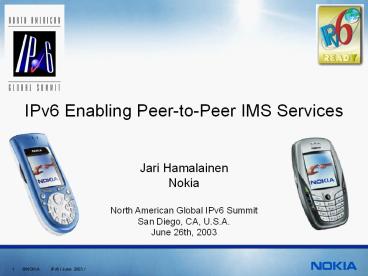IPv6%20Enabling%20Peer-to-Peer%20IMS%20Services - PowerPoint PPT Presentation
Title:
IPv6%20Enabling%20Peer-to-Peer%20IMS%20Services
Description:
IP will increase usage through reachability of users, seamless usage of ... IP Multimedia Subsystem (IMS) is a service infrastructure based on the use of ... – PowerPoint PPT presentation
Number of Views:45
Avg rating:3.0/5.0
Title: IPv6%20Enabling%20Peer-to-Peer%20IMS%20Services
1
IPv6 Enabling Peer-to-Peer IMS Services
Jari Hamalainen Nokia North American Global IPv6
Summit San Diego, CA, U.S.A. June 26th, 2003
2
Agenda
- IP multimedia services
- IMS and IPv6
- Example of peer-to-peer IP connectivity
- Technology and application trends
- Multi-access IMS
- Conclusions
3
IP multimedia services
The four key changes
- Richer person-to-person communication
- IP will increase usage through reachability of
users, seamless usage of different communication
types and easy-to-use group communications. - Richer interaction between media streams
- Easy integration and interworking of
differentIP-based services. - Service mobility
- Consistent services over various differentaccess
networks increase usage and reduce churn. - Easier service creation and integration
- Well defined open APIs and programminglanguages
enable service creation by3rd party developers.
4
Global SIP/IMS deployment needs IPv6
- Introduction of SIP-based peer-to-peer services
is an important step after current client-server
based services. - IP Multimedia Subsystem (IMS) is a service
infrastructure based on the use of Session
Initiation Protocol (SIP). - 3GPP Release 5 and 6 specifications
- 3GPP2 specifications
- In order to make peer-to-peer services work
between different operators' networks, IPv6 is
needed - peer-to-peer services work well only
with public IP addresses. - Small scale IMS deployment / piloting can be
started with IPv4. - IPv6 is vital for wider scale, global IMS
deployment.
5
Example of peer-to-peer IP connectivity
CSCF
UMS
Accept
IPv6
Thomas
Peter
Invite player
Chat
Push to Stream
Quit
6
Example of peer-to-peer IP connectivity
CSCF
UMS
IPv6
Chat
Thomas
Peter
Invite player
Peter 000000 Thomas 000000
Chat
Chat
Push to Stream
Quit
7
Example of peer-to-peer IP connectivity
CSCF
UMS
IPv6
Streaming video
Thomas
Peter
Invite player
Peter 000000 Thomas 000000
Chat
gt Peter hey, look what just passed by!
Push to Stream
Quit
8
Future mobile services serverless media
CSCF
UMS
IPv6
Thomas
Peter
The SIP/IMS user plane is peer-to-peer in nature
- SIP/IMS sessions between mobiles in different
Private IPv4 address spaces become highly
complicated. This is why public IP addresses are
required. The only future proof solution is
provided by IPv6.
9
Standardized technology enablers for new mobile
services are here today
IPv6
SIP
Color displays
XHTML and TCP/IP
MMS
Imaging and camera integration
GPRS EDGE WCDMA CDMA2000
Multimode
Video
Bluetooth WLAN
MultimediaStreaming
Positioning
Symbian
MIDI
Presence
Java
DRM
10
Technology and application trends
- 2G radio interface(GSM / EDGE)
- IPv4
- Client-server connectivity
- SMS text messaging, WAP browsing, MMS multimedia
messaging
- 2G and 3G radio interfaces (WCDMA / CDMA2000)
- IPv4/IPv6 dual stack
- Peer-to-peer connectivity
- Richer, IP-based Applications
- HTTP/TCP/IP browsing
- Presence
- Instant Messaging
- Multimedia streaming
- Gaming
- Voice and video telephony
- Sharing
- Etc.
11
Multi-access IMS
S-CSCF
IMS (IPv6)
P-CSCF
3GPPaccessnw
GGSN
P-CSCF
P-CSCF
3GPP2accessnw
PDSN
WLANaccess nw
- Common IP version (IPv6) makes the multi-access
case much easier
SIP Signaling for building up the session
User IP data
12
Conclusions
- Introduction of SIP-based peer-to-peer services
is an important step after current client-server
based services. - IPv6 enables global IMS-based peer-to-peer
services. - IMS services will in the first phase be accessed
via 3GPP and 3GPP2 radio access networks. WLAN
will follow. - Communications between cellular terminals and
Internet clients (WLAN and fixed networks)
enables successful business.
13
(No Transcript)































